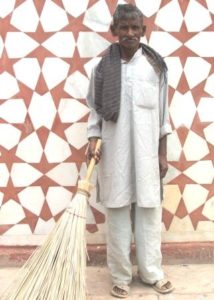The slums
Estimates put the number of slum areas in Jaipur at between 200 and 400. Over 20% of Jaipur’s inhabitants live in slums.
The students of the Wisdom Academy are living in various ‘bastis’ (slum colonies) in west Jaipur. Their families migrated here from rural areas all over India in the hope to find better lives. But they ended up settling in slums, where they lack access to decent housing, healthcare and education. In effect, they traded rural for urban poverty.
Illegal settlements
As the slums are unauthorized settlements, government tends to ignore these areas. Most slums lack even the most basic civic infrastructure, including sewage systems, adequate sanitation facilities, electricity, and clean water. The residents often get their running water and power through illegal tapping of public connections.
 The slums vary in size and conditions. In the poorest ones, people are living in very simple huts made of wood, mud and plastic sheets. In the better-equipped slum areas families live in one room brick houses with corrugated iron roofs. Sometimes, a few common toilets and bathrooms are built, to be shared by hundreds of people. But most slum dwellers have no access to any kind of sanitation facilities, so they defecate in the open (as does over 50% of India’s population, by the way).
The slums vary in size and conditions. In the poorest ones, people are living in very simple huts made of wood, mud and plastic sheets. In the better-equipped slum areas families live in one room brick houses with corrugated iron roofs. Sometimes, a few common toilets and bathrooms are built, to be shared by hundreds of people. But most slum dwellers have no access to any kind of sanitation facilities, so they defecate in the open (as does over 50% of India’s population, by the way).
Livelihood and income
The slums are located near (lower) middle class neighbourhoods, close to job opportunities. Women are working in middle class homes as household help or as cook. Men work as painters, sweepers, deal in scrap metal or waste plastic, or work in factories.
Men work as painters, sweepers, deal in scrap metal or waste plastic, or work in factories.
In some bastis, people are working in construction. These families used to live as nomads. But with the enormous expansion of construction activities in Jaipur in the past two decades, there is no need to migrate anymore. They now live in permanent settlements near the many construction sites in the colony where they reside. Also the women do tough jobs. They carry head loads of bricks, cement and sand weighing up to 40 kg.
Most slum dwellers are daily wagers, being low paid for their labor-intensive jobs. Many families live below or just above the poverty line of USD 1.25 per day.
Common problems
Besides poverty, slum residents face many problems:
- The poor sanitary conditions, and poor water quality create serious health hazards. They make the inhabitants vulnerable to infections, spread (water-borne) diseases rapidly, and lead to preventable illnesses such as diarrhoea.
- Proper medication to treat diseases and health problems is lacking. The slum dwellers often can’t afford to spend money on medicines.
- Alcohol or drug abuse and gambling cause even bigger money problems and regularly lead to domestic violence. Many of the men are alcoholics.
- Some families have (ever growing) debts. They take loans from middlemen at interests of 50% or more.
- Most dwellers are low-caste and suffer discrimination because of that.
Click here to view the photo gallery ‘The slums’.




